-
Car Reviews
- All reviews
- Midsize SUVs
- Small cars
- Utes
- Small SUVs
- Large SUVs
- Large cars
- Sports SUVs
- Sports cars
- Vans
Latest reviews
- Car News
-
Car Comparisons
Latest comparisons
- Chasing Deals
Land Cruiser is a nameplate that has always excelled in the toughest conditions, and that rings true for the safer 79 Series single cab, but it’s not without fault

The Toyota Land Cruiser 70 Series has been around since 1984 when it replaced the 40 Series and has found homes all across Australia – more than 1.15 million have been sold here, in fact. Australians have been instrumental in the 70 Series’ popularity and, in 2019, our market took first place globally with 13.1 percent of all 70 Series sales.
There have been myriad changes to the 70 Series along the way including front coil springs (1999) and a substantial front-end remodelling to fit a V8 where inline sixes used to sit (2007), but none of them so significant enough to really change what this single-cab, dual-cab or wagon is at heart: an agricultural vehicle with its roots in the 1980s. Yet Australians still love this vehicle, with 4671 examples delivered from January to the end of May this year.
So, enter the 70th anniversary Land Cruiser 79 Series we have on test. Wearing 300 Series GR Sport-esque ‘Toyota’ lettering in the grille, different 16-inch alloys, black bumpers, LED fog and daytime running lights as well as an array of badges inside and out, you can (or could, as they’re all-but sold-out) choose one of three colours: French Vanilla (as-tested), Merlot Red or Sandy Taupe.
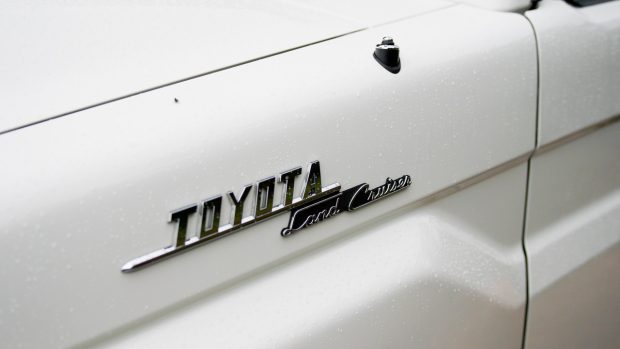
The 70th anniversary production run was strictly limited to 600 total units of which the Single Cab 79 Series makes up 200 examples, the dual-cab the bulk (320) and a handful of 76 Series wagons (80) making their way to Australian dealers.
The 76 Series Wagon-bodied example introduced in 2007 may be popular with the four-wheel-drive touring crowd, but this 79 Series cab-chassis ute is the foundation on which the 70 Series legacy is built. So much so, that Toyota went to the trouble of ensuring the single cab on test was rated with five ANCAP stars in 2016 by fitting a driver’s knee and curtain airbags to keep OH&S departments happy.
That five-star ANCAP score may be set to run out in 2023 and will affect the viability of 79 Series as fleet vehicles, but it’s unlikely to drastically drop in popularity given its sold-out status and some dealers reporting up to a four year wait.
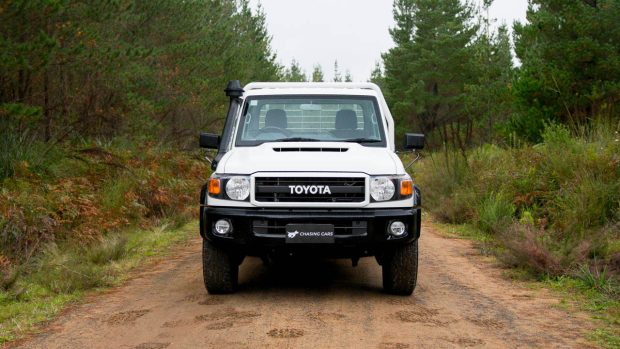
But aside from the 79 Series story, how is this agricultural beast to live with on a daily basis? Is it stocked with enough comfort, safety and road-holding to justify its rather high $80,050 (before on-road costs) price of entry? Or should you look into newer, bigger rivals such as the RAM 1500 and Chevrolet Silverado 1500 for a better blend of old-school V8 muscle and modern technology?
Driving a 70 Series Land Cruiser is not a task to be taken on lightly. The gearshift is chunky, the recirculating ball steering box hefty and requires several full rotations of the 4.4 turns lock-to-lock steering to circumnavigate the 5230mm-long 79 Series’ 14.4-metre turning circle.
The 79 Series is not necessarily at its best while pootling around Sydney’s Inner West – that should be little surprise – but it is also not without its charms. Passers-by seem to love the Cruiser’s honest simplicity.
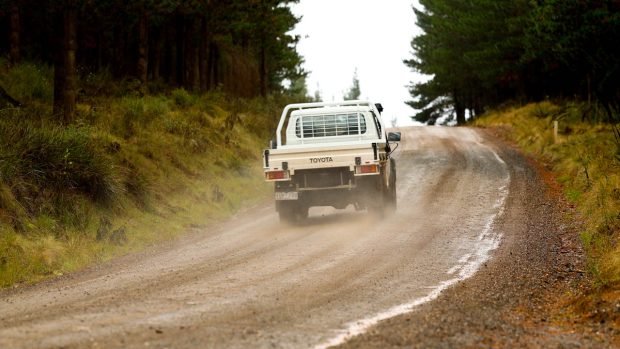
You also have to interact with the heavy controls in a sympathetic (but firm) way to extract what the 152kW/430Nm 4.5-litre single-turbo diesel V8 has to offer. The engine doesn’t breathe well above about 3000rpm, though the effortless torque from 500rpm means it’s possible (but not wholly advisable) to creep off the line in at least third gear.
The torquey V8 is helped by the Land Cruiser’s short five ratios, though that does mean this is a tiring vehicle to keep up with motorway traffic. The Land Cruiser will sit in the right lane of the Hume at 110km/h, but in doing so the engine is turning 2400rpm and causing quite a racket. Instead, the Land Cruiser’s default gait is about 85-100km/h, best served on flowing country roads where the 79 Series is reasonably surefooted, for this type of vehicle.
Out of the box this 70th anniversary is equipped with 16-inch alloy wheels and 265/70 R16 tyres, which make for a terse low-speed ride but the trade-off is confidence on dirt roads and trails. There are also weighty manual levers to select four-high, four-low as well as lock the front, rear and centre differentials – with no electronic nannies to fiddle with further than ABS (introduced in 2012) and a surprisingly well-calibrated ESC tune.
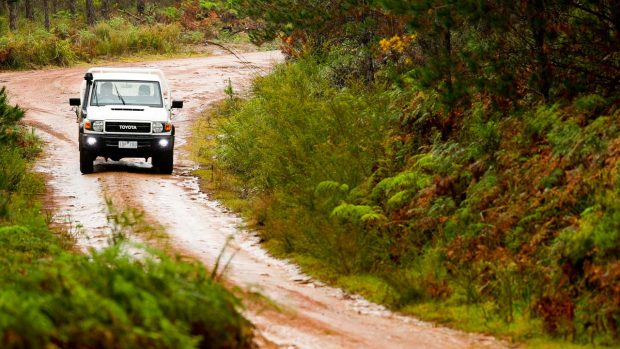
The myriad aftermarket accessories, parts and modifications already available for the Land Cruiser 70 Series range gives further ability to tailor this vehicle to your tastes: if you want to cross the outback there are canopies, roof tents, suspension lift kits, uprated dampers, bash plates, different final drive ratios all available already. That means no ‘beta-testing’ development – no taking chances with new products – so you can cruise into the unknown safe in the knowledge the hard work is done for you.
The Land Cruiser 70 Series family can also be set up to make a fantastic tow car. Its 3500kg towing capacity may only match that offered by smaller utes such as the Isuzu D-Max (3500kg), however there’s an effortless, under-stressed nature to the Cruiser’s turbo-diesel donk that suggests it would be the better choice in the real world.
There are also many performance chips to unleash a bit of extra grunt, should you wish. Ultimately though, the 76 Series Wagon – or dual-cab 79 Series with some accessories on the tray – would probably be the better pick for towing than the single-cab on test.
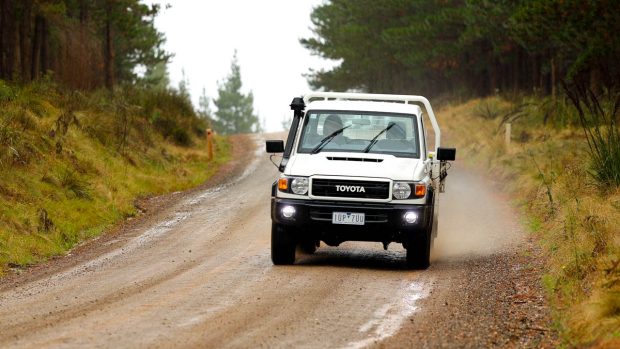
Driving the Land Cruiser 79 Series single-cab unladen is actually a more pleasurable experience than the 76 Series wagon, likely owing to the single-cab’s 400mm longer wheelbase (3130mm) that calms the ride, though it’s still busy, choppy and overly-firm when unladen. Likely, with some of the 79 Series’ 1225kg maximum weight in the tray, its ride would improve.
Safety is not the 70 Series’ strongest aspect, yet the single-cab still carries its ANCAP five star rating from 2016 (just, with it set to expire at the end of this year). To continue sales to large mining and farming fleets – where the 79 Series cab-chassis is most popular – a driver’s knee and curtain airbags were engineered, along with additional chassis reinforcements.
There are no modern systems such as AEB, lane-departure warning, blind-spot monitoring, front or rear parking sensors, or even a reversing camera. However, the Land Cruiser’s blocky shape, thin pillars and large mirrors provide excellent forwards, sideways and rear visibility.
The 79 Series’ cabin matches the way this ute drives – functional, simple, and arcane. There are few real creature comforts, though the air-con blows Toyota’s signature freezing cold breeze.
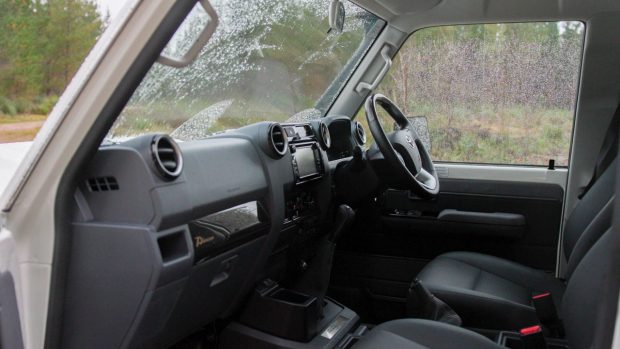
That 6.1-inch touchscreen is tiny – though it does have Bluetooth audio streaming and phone connectivity – and there is no smartphone mirroring. The pair of paper-cone speakers are simply woeful. Exterior noise insulation from tyres, wind and suspension is also very poor while the cloth-appointed, fore-aft and backrest adjustable front seats offer little support.
Toyota has gone to the trouble of adding some cabin storage including a square cup holder and small centre console around the manual handbrake, but there isn’t a comfortable armrest there or really on the door either.
The dash design itself is straightforward to interact with but looks like a melange of old and new tech, because it is.
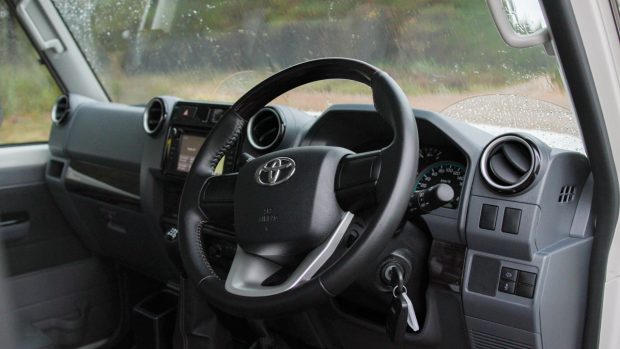
Luckily, a lot of these criticisms can be addressed by buyers. With its strong cult following, the 70 Series has ample aftermarket support with centre consoles, affordable Recaro seats to replace the standard items, head units with built-in Apple CarPlay, sound system knowledge, cabin insulation and more options already well-and-truly explored.
Being the single-cab, this 79 Series is only a two-seater and there is limited cabin storage behind the front seats. There’s enough space for work boots, bags and an umbrella, but not a whole lot more stowage space.
The trade-off is the Land Cruiser’s generous tray. Our test car was fitted with a genuine Toyota alloy tray, but there are plenty of options depending on the direction you wish to take your 70 Series.
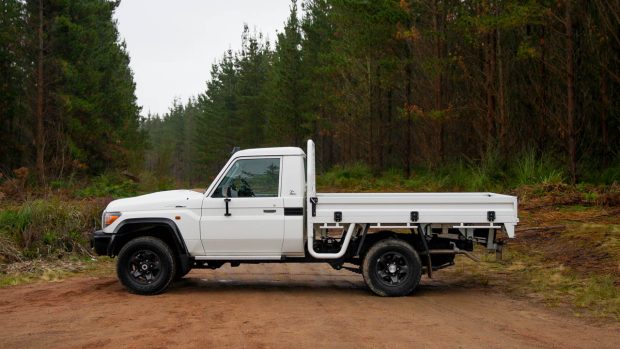
Of the many reasons to buy a Toyota Land Cruiser, reliability and dependability are most important. Service intervals are set officially by Toyota every six months or 10,000km at a price of $3750 over five years/100,000km.
On price alone, the 70 Series isn’t that enticing next to a more tech-filled Toyota product such as a Kluger large SUV ($1250 for five years) or Hilux ute ($1300) but that doesn’t tell the whole story.
The parts that make up the 79 Series single-cab have been around since at least 2007, when its significant facelift brought a wider front track to fit the 4.5-litre turbo-diesel V8. That means if you and your Cruiser are stranded in the middle of nowhere, it’s much more likely the local mechanic will have bits to fix your ute than someone’s Land Rover Discovery or Defender.
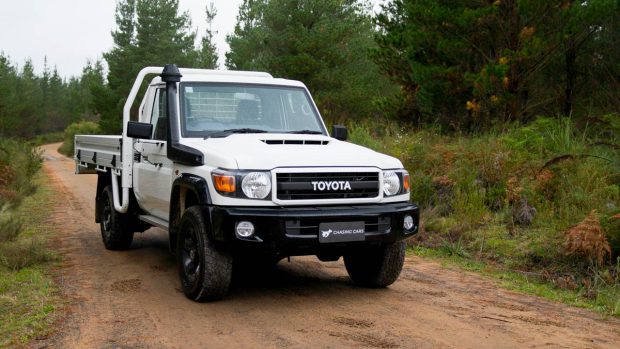
The Land Cruiser’s bluff front-end and short fifth-gear sees it record 10.7L/100km in ADR combined consumption testing. On our circa-700km with highway, off-road and urban driving loop we returned 12.7L/100km.
With its 130-litre diesel capacity, even at nearly 13L/100km the 79 Series carries enough diesel on board to travel more than 1000km between refills, which is great in a huge country like Australia.
Toyota backs the Land Cruiser 70 Series range with a five-year/unlimited kilometre warranty, that extends to seven years for any rust or body perforation issues.
The honest simplicity that pervades the Land Cruiser 79 Series experience is one that has evaporated from the newer 300 Series (and prior 200 Series), which is a nice way of saying the 79 Series won’t suit everyone.
But for those who want a rugged off-roader that can be tailored to your tastes for hitting trails, doing farm work without breaking a sweat or towing a 3500kg luxury caravan across the country then there are few more proven options than a 70 Series Land Cruiser, and that’s why buyers are still queuing up in droves to get their hands on this vehicle.
That said, as we approach the expiry of the 70 Series’ five-star ANCAP score it’s probably time Toyota stepped in and made this popular four-wheel-drive a more palatable option with the addition of some expected safety tech such as AEB and a reversing camera.
Variant tested GXL 70TH ANNIVERSARY SPEC EDT
Key specs (as tested)
About Chasing cars
Chasing Cars reviews are 100% independent.
Because we are powered by Budget Direct Insurance, we don’t receive advertising or sales revenue from car manufacturers.
We’re truly independent – giving you Australia’s best car reviews.
The estimate provided does not take into account your personal circumstances but is intended to give a general indication of the cost of insurance, in order to obtain a complete quote, please visit www.budgetdirect.com.au. Estimate includes 15%^ online discount.
^Conditions Apply
Budget Direct Insurance arranged by Auto & General Services Pty Ltd ACN 003 617 909(AGS) AFSL 241 411, for and on behalf of the insurer, Auto & General Insurance Company Limited(ABN 42 111 586 353, AFSL 285 571).Because we don’t know your financial needs, we can’t advise you if this insurance will suit you. You should consider your needs and the Product Disclosure Statement before making a decision to buy insurance. Terms and conditions apply.
Indicative quote based on assumptions including postcode , 40 year old male with no offences, licence suspensions or claims in the last 5 years, a NCD Rating 1 and no younger drivers listed. White car, driven up to 10,000kms a year, unfinanced, with no modifications, factory options and/or non-standard accessories, private use only and garaged at night.
^Online Discounts Terms & Conditions
1. Discounts apply to the premium paid for a new Budget Direct Gold Comprehensive Car Insurance, Third Party Property Only or Third Party Property, Fire & Theft Insurance policy initiated online on or after 29 March 2017. Discounts do not apply to optional Roadside Assistance.
2. Discounts do not apply to any renewal offer of insurance.
3. Discounts only apply to the insurance portion of the premium. Discounts are applied before government charges, taxes, levies and fees, including instalment processing fees (as applicable). The full extent of discounts may therefore be impacted.
4. We reserve the right to change the offer without notice.